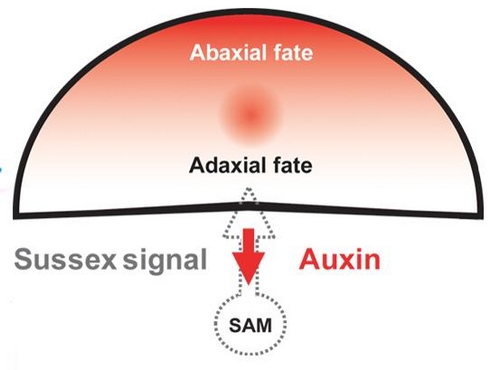Stem cells not only initiate organs, but may also contribute to organ patterning, at least in the shoot apex of flowering plants: classical microsurgical experiments imply that the shoot apical meristem promotes development of the leaf adaxial side, i.e. the upper side (Sussex, 1951, Nature 167:651-652). A “Sussex signal” has been proposed as a hypothetical molecule that passes from the shoot apex stem cells to the adaxial domain of an incipient leaf primordium to promote adaxial domain formation (grey arrow in Figure 1). However, the chemical basis of this signal remains an enigma, as does its mode of transmission, and how it acts in leaf polarity.
Earlier studies from the formal Shanghai Institute of Plant Physiology, Chinese Academy of Sciences (CAS) suggested that auxin is involved in leaf polarity (Ni et al., 1999, Cell Res. 9:27-35). Following this direction, researchers from JIAO Yuling’s group, at the Institute of Genetics and Developmental Biology, together with colleagues from Caltech and ENS-Lyon, showed the existence of a transient low auxin zone in the adaxial side that contributes to adaxial development.
They further found that this adaxial low auxin zone results from auxin transport from leaves to the shoot apex (red arrow in Figure 1). Thus, it is not a positive signal from stem cells, but departure of a signaling molecule from primordia to stem cells, that delivers polarity information -- opposite to what is generally assumed. The auxin signal is mediated by the auxin-responsive transcription factor MONOPTEROS (MP), whose constitutive activation in the adaxial domain promotes abaxial cell fate. This study provides an explanation for the hypothetical meristem-derived leaf polarity Sussex signal.
This work has been online published in
PNAS online Early Edition on December 16, 2014
(DOI: 10.1073/pnas.1421878112), with graduate student QI Jiyan and postdoctoral fellow WANG Ying as co-first authors. This research was supported by National Basic Research Program of China, National Natural Science Foundation of China, the State Key Laboratory of Plant Genomics, and CAS.
Figure1. Conceptual model of the influence on polarity of polar auxin transport from the leaf axil to the SAM. (Image by IGDB)





